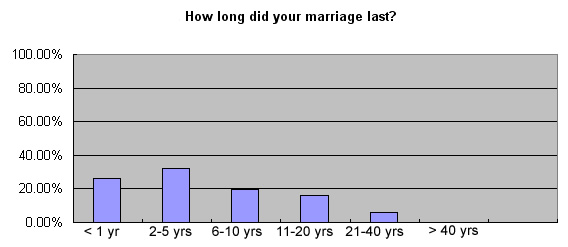Divorce in the Muslim Community: 2010 Survey Analysis
 By Taha Ghayyur
By Taha Ghayyur
If you attended six Muslim weddings this summer, chances are that two will end up in divorce sooner or later. This is based on research conducted in the early 1990s by the late, New York-based sociologist Ilyas Ba-Yunus, who estimated the North American Muslim divorce rate stood at 31.14 percent, which was three times higher than the highest divorce rate in the Muslim world at that time (10 percent in Egypt and Turkey).
The situation hasn’t gotten better in North America over the last two decades. In fact, Imams, counselors, and lawyers are constantly indicating an increase in Muslim clients seeking help for marital crises and filing for divorce.
To understand this disturbing phenomenon, Sound Vision conducted an online survey from October 15, 2009 to January 15, 2010, in which 405 individuals across North America shared their divorce experience, including the factors that lead to divorce, as well as how they dealt with it.
Here are the detailed results of this survey for the benefit of social service providers, family counsellors, Imams, Muslim educators and the Muslim community at large.
Demographics:
Of those who responded to this survey:
1. Majority were female (82.71%)
2. Highest number belonged to 26 to 40 age group (56.04%), followed by 41 to 55 bracket (28.06%). Only about 6% belonged to 18 to 25 and 56 to 60 age groups each
3. Majority were of South Asian (Pakistani/Bangladeshi/Indian) (28.28%) descent, 17.85 were African Americans, 16.16% were white, and 11.11% were of Arab background
4. Most were currently employed (56.23%) and 15.82% were homemakers (only women)
5. 83.33% reside in the USA or Canada
6. Over half were born in the USA or Canada; the rest were born in a Muslim country
7. Over 60% indicated that their ex-spouse was born in a foreign country. Less than one third of the ex-spouses were born in the USA or Canada
8. Over 40% of the participants had been divorced for 2-5 years, over a quarter were divorced for less than 1 year, and about 17% for 6 to 10 years.
9. About 50% indicated they had been divorced only once and about 25% experienced divorce twice. One person had been divorced five times.

First Five Years: Most Critical Time
For a third of the participants, marriage lasted two to five years; for a quarter of them, it lasted less than one year. About 20% of them stayed married for six to 10 years, 16% for 11 to 20 years, and 6% for 21 to 40 years.
The fact that majority of divorces occurred within the first five years of marriage clearly illustrates the need for spouses to work harder to protect, strengthen, and nurture their relationship. It is in these initial years that most of the challenges that shake the foundation of a marriage arise.
Current Marriage Status: More Men Re-Married
Out of the 405 respondents, only 31.63% were currently married; 56.55% were currently divorced and 11.82% were separated.
Not surprisingly, a far higher percentage of men (47.06%) re-married, compared with women (26.78%). This finding reinforces the common observation that women in the Muslim community in particular have a harder time re-marrying due to the stigma attached to women getting divorced.
More Women Initiating Divorce
About two-thirds of the participants initiated the divorce themselves, versus the one-third whose spouses started the process.
The fact that 64.32% of Muslim women respondents admitted that they initiated the divorce process beckons a new trend in the North American Muslim communities. More Muslim women are making crucial decisions involving marriage and divorce on their own. Unlike in traditional Muslim societies, North American Muslim women speak their mind, make more informed decisions, and are less likely to tolerate spousal or family abuse.
Incompatibility: #1 Reason for Divorce
Incompatibility was the most cited reason for divorce (16.38%), followed by abuse (13.12%), financial disputes (10.41%), family / in-laws interference (10.20%), sexual infidelity / adultery (8.79%), and others.
If we add the results of “religious incompatibility: lack of practice” and “religious incompatibility: extreme practice” to the general “incompatibility” factor, it comes out to 25.71%.
While every warring couple could cite multiple reasons for the break up, there is always one major factor that leads to the death of a marriage. Some of these factors are detectable and even preventable before the marriage. Compatibility or lack thereof between potential spouses can be determined with good scrutiny prior to official union.
The compatibility factor becomes more pronounced when one spouse was born and raised in North America and the other in the Muslim world. In our survey, over 50% of the respondents were born in North America, while only one third of the ex-spouses were born on the continent.
It can be argued that ‘incompatibility’ is also a convenient excuse or scapegoat some couples use to end their marriage due to relatively minor lifestyle inconveniences they go through after marriage.
Emotional Abuse: Most Common form of Abuse
Those who indicated abuse as one of the reasons for divorce chose emotional abuse as the most common form of abuse they experienced. About one-third (32.32%) of individuals chose emotional abuse, while one-fifth (21.80%) selected verbal abuse, followed by financial abuse (14.79%), physical abuse (13.87%), spiritual abuse (8.99%) and sexual abuse (5.79%).
Surprisingly, a slightly higher percentage of men indicated emotional abuse (37.70%) to be the main form of abuse they suffered, as opposed to 31.26% women. This is similar to the findings for verbal abuse: 24.59% men cited it as one of the forms of abuse they experienced in their relationship, while 21.49% women chose the same.
Understandably, more women than men ranked financial abuse, physical abuse, and spiritual abuse as a higher form of abuse they experienced in the marriage.
Emotional abuse and verbal abuse, the most common forms of abuse cited, are also perhaps the most dangerous because they are often not as overt and explicit as other types of abuse. A spouse may continue to silently suffer under emotional and verbal abuse for years until one day it becomes intolerable.
Moreover, the abuser may not even know at times that his or her actions, based on cultural upbringing or nature, are hurting his or her spouse’s feelings and could be detrimental to their relationship. This is why clear communication about expectations even before one decides to get married is crucial.
Children from the Marriage
Over two-third of the divorced individuals reported that they had children from the failed marriage, out of which 22.19% had disputes over the custody of children.
Three-quarters of the women surveyed had children living with them and only a quarter of the men surveyed had children living with them. The rest of the respondents indicated that their children were split between mother and father; others would have their children stay with one parent certain days of the week and on other days with the other parent.
About a quarter also had children from earlier marriages.
Family Support
A decisive majority of the participants (82.12%) had their family’s support and blessing in the process of divorce. Women seemed to have more support from their family (84.68%) than men did (67.39%). This again points to a shift in the Muslim community away from traditional ideas, where parents abhor and resist the idea of their children divorcing at any cost and spouses (especially wives) are encouraged to bear with a miserable relationship for the sake of the family’s honor or reputation, and the couple’s children.
Family and relatives were also ranked highest by respondents as those from whom they sought help to resolve the differences with their spouse before initiating divorce: 28.27% approached their family / relatives, 22.44% went to their Imams or local religious leaders, and 21.53% asked their friends for help, followed by a Muslim counselor (8.82%), a lawyer (7.52%), and a non-Muslim counselor (7.39%).
The fact that about half of the couples approached their families or local Imams for help reflects the urgent need for equipping family members and community leaders, in particular, with tools and resources for family counseling and the knowledge of Islamic marriage laws, as well as the legalities of marriages and divorce in the country they are living in. Professional marriage counselors in the community should also be known to the wider community and should work closely with Imams for referrals as needed.
Community Response
In response to “What was your local Muslim community’s reaction to your divorce?”, 24.84% indicated negative, 12.74% received positive reaction, and 31.85% felt the community reaction was neutral. It is revealing to note that 30.57% of the participants did not publicize the divorce in the community, hence there was no reaction.
While divorce is not something encouraged by Islam, especially when all the means of reconciliation have not been exhausted, it is not something to be kept hidden from the community. The fact that about a third of the respondents decided to keep their divorce hidden, shows how much stigma divorce still carries in our community.
Moreover, when asked “Did you feel your local Muslim community gave you the support you needed while divorcing?” most said no (49.34%), 27.63 indicated yes, and 23.03% received some support.
For the majority of the couples, divorce was processed by a lawyer (48.08%) and for 19.55% it was handled by their Masjid or an Imam. The rest (32.37%) resorted to other means, including a professional mediator, judge, Shariah council/arbitrator, friend, or “verbal Talaq pronouncement three times.”
Current Level of Happiness
The response to “Are you better off today than you were in this marriage?” was a resounding YES (90.61%).
Of those who indicated they were happy with the decision to divorce, 31.64% were currently married, 57.45% were not married, and 10.91% were separated.
Moreover, of those who are happier today, 66.19% initiated the divorce themselves.
Interestingly, the income level of participants did not seem to emerge as a factor in the frequency of divorce. Our survey respondents were quite evenly distributed across all income levels, from “under $15,000” to “$75,000-$149,999” income brackets.
——————————
Taha Ghayyur is Sound Vision’s Development Manager and has been writing on leadership, lifestyle, and self-help issues since 1997. He is a director of MuslimFest, a project of Sound Vision, which is an award-winning annual festival celebrating the best in Muslim arts and entertainment held annually in Toronto, Canada.
